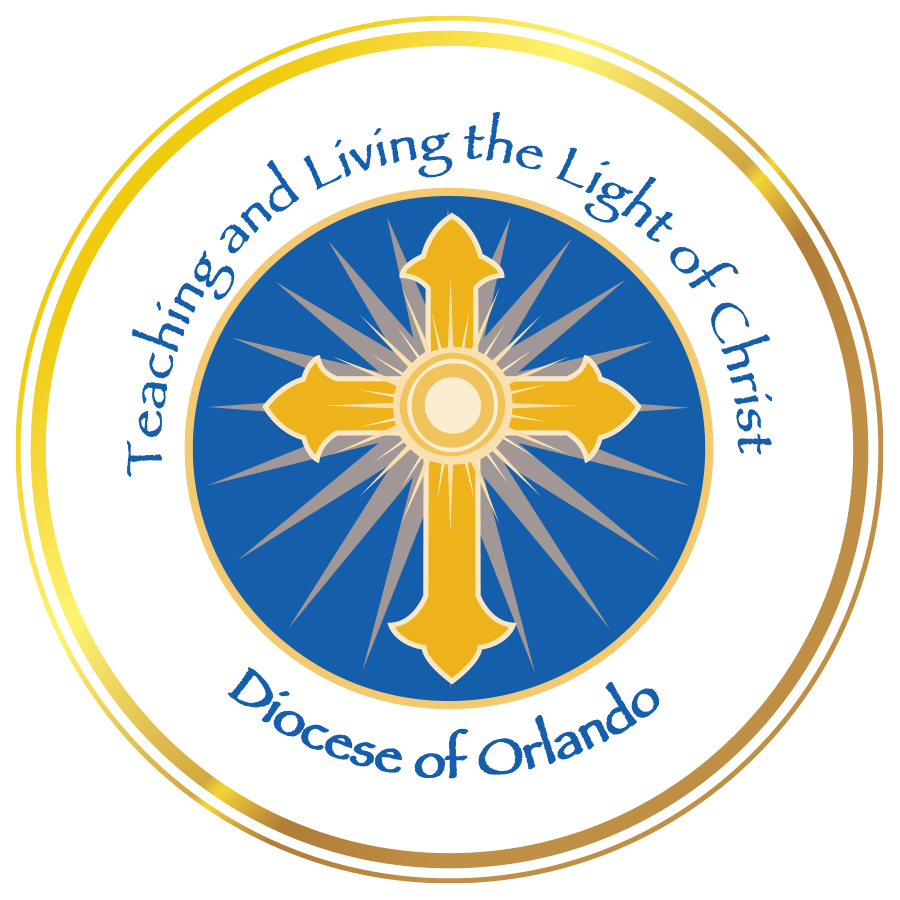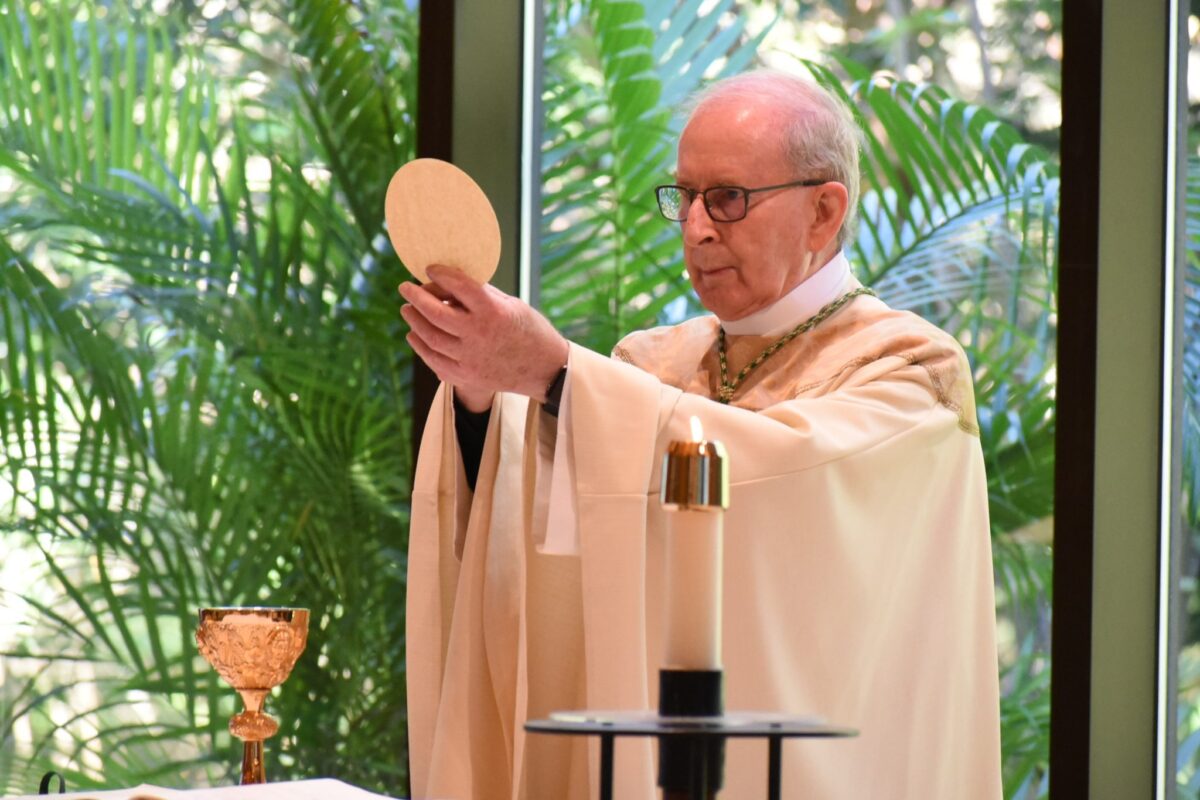ORLANDO | This third article on the meaning of the Mass addresses the Liturgy of the Eucharist. Having united as the people of God, heard and responded to the Word of God proclaimed in our midst, and having renewed our faith in the Creed and exercised our sharing of the priesthood of Christ through the universal prayer, we now continue with the celebration of the Liturgy of the Eucharist.
Each part of the Mass at this point has served to call us to a deeper and deeper encounter with Christ by the power of the Holy Spirit. For the Spirit has called us to manifest Christ’s body, the Church, that we may share in the perpetual sacrifice of Jesus Christ on the cross; the most perfect sacrifice to God our heavenly Father.
The General Instruction on the Roman Missal (GIRM) provides insight and understanding of what is accomplished in the Liturgy of the Eucharist: “At the Last Supper, Christ instituted the paschal sacrifice and banquet, by which the sacrifice of the cross is continuously made present in the Church. … For Christ took the bread and the chalice and gave thanks; he broke the bread and gave it to his disciples, saying, ‘Take, eat, and drink: this is My Body; this is the cup of My Blood. Do this in memory of Me.’… Accordingly, the Church has arranged the entire celebration of the Liturgy of the Eucharist in parts corresponding to precisely these words and actions of Christ” (GIRM, 72).
THE PREPARATION OF THE GIFTS
The preparation of the gifts includes various liturgical actions of preparation: preparation of the altar; presentation of the gifts; placing of the gifts on the altar; mixing of wine and water; incense; washing of hands; prayer over the offerings. All of these actions correspond to the actions of Jesus Christ at the Last Supper as it has been handed down to us by the apostles.
Of particular note is the assembly’s role in the procession of the gifts as it is a ritual gesture that reflects the participation of all present at the Eucharistic Sacrifice. The gifts of bread and wine come from the assembly. They are the fruit of God’s creation and the work of human hands — that which will become for us the Body and Blood of Christ. The Church also recommends that money or other gifts for the poor and for the Church are received at this time.
Recall the Scripture passage from Matthew 5:23-24: “Therefore, if you bring your gift to the altar, and there recall that your brother has anything against you, leave your gift there at the altar, go first and be reconciled with your brother, and then come and offer your gift.” By this ritual gesture, not only are the altar and the bread and the wine prepared, but we ourselves as we seek some share in Christ’s sacrifice offered once and for all. Having reconciled with one another the gifts we offer are the expression of a humble and contrite heart — a true offering in charity and in love. By this holy exchange we ready our hearts to offer ourselves with Christ; by dying to self, we can truly offer our lives with Christ, who offered himself upon the cross. We pray that as the bread and wine are changed into the Body and Blood of Christ, we may be transformed more and more into the likeness of Christ and truly become His mystical Body. This is most eloquently stated when all has been prepared, the assembly stands and the priest celebrant says: “Pray, brothers and sisters, that my sacrifice and yours may be acceptable to God, the almighty Father.” The assembly replies: “May the Lord accept the sacrifice at your hands for the praise and glory of His name, for our good and for the good of all His holy Church.”
THE EUCHARISTIC PRAYER
Now the center and summit of the entire celebration begins: the Eucharistic Prayer. It is prayed by the priest-celebrant in the name of the entire assembly. Because of the solemn nature and importance of the Eucharistic Prayer, the priest may sing all or certain parts of it. At least the Sanctus (Holy, Holy,), the mystery of faith, and the Amen should be sung.
The Eucharistic Prayer contains many types of prayers within it. It begins with a dialogue between the priest-celebrant and the assembly: “The Lord be with you … lift up your hearts … let us give thanks to the Lord our God.” The preface to the Eucharistic Prayer is in the form of a thanksgiving and ends with the singing of the Sanctus (Holy, Holy.) Our participation in this acclamation — Holy, Holy, Holy Lord God of hosts — is a mystical union with the Church throughout the ages and the angels in heaven who forever sing at the eternal wedding feast of the Lamb of God.
The Eucharistic Prayer continues as the priest celebrant offers thanks and praise to God the creator in the name of the faithful people of God who have gathered. God’s marvelous deeds of creation, His covenant with His people, and the great mystery of our redemption through His Son, Jesus Christ, are remembered in the spoken words of the priest-celebrant. The Holy Spirit is called upon the elements to be consecrated for it is through the Holy Spirit that God remains present in the Church. This invocation of the Holy Spirit is known by a Greek word “epiclesis.”
Then the words of Christ himself are prayed over the gifts. This part of the Eucharistic Prayer is known as the consecration and Christ’s words are often referred to as the “institution narrative.” The assembly is then invited to acclaim the great mystery that is being manifest in our midst and we proclaim the mystery of faith: the paschal mystery. As we remember with the words, “We proclaim your death, O Lord, and profess your resurrection until you come again,” we celebrate our share in Christ’s sacrifice at Calvary and the reality of that sacrifice present in the Eucharist we celebrate today.
This part of the Eucharistic Prayer is called “anamnesis,” which is a Greek word meaning “to remember.” However the kind of remembering that this word refers to is much more evocative, for in the “anamnesis” before the real presence of Christ in the sacred body and blood here and now in this celebration, we become participants and benefactors in the sacrifice of salvation through Jesus Christ.
The Eucharistic Prayer continues with what is called the offering. As the priest-celebrant offers in the Holy Spirit the spotless victim, Christ, to the Father, so too we offer our very lives that through Christ, in the Holy Spirit we may be in union with the triune God “so that at last God may be all in all.” (GIRM, 79)
The intercessions that are part of the Eucharistic Prayer are meant to unite our prayer in communion with the Church on earth together with the pope, who is the sign of the Church’s unity, Mary and Joseph, and the communion of saints in making a perfect offering for all the living and the dead.
The Eucharistic Prayer ends with what is called the “doxology” which comes from a Greek word meaning “glory.” The priest-celebrant prays the words “through him, and with him, and in him, O God almighty Father in the unity of the Holy Spirit all glory and honor is yours, for ever and ever.” The assembly confirms this proclamation of glory to the triune God with the word, “Amen.”
With the conclusion of the Eucharistic Prayer the assembly begins immediate preparation for the reception of the Body and Blood of Christ.
By Bruce Croteau, Special to the Florida Catholic, December 15, 2022
Read Part Four: The Meaning of the Mass Holy Communion: The Sacrament of love and unity

